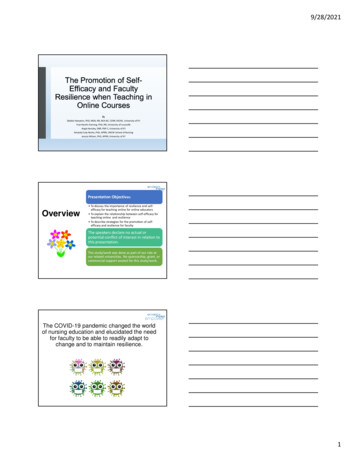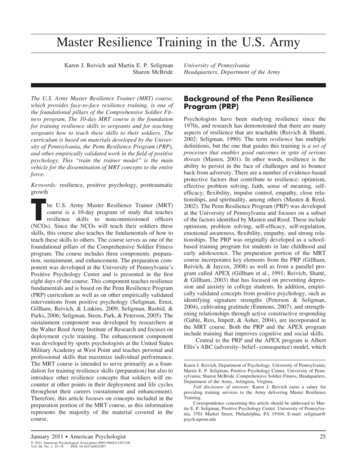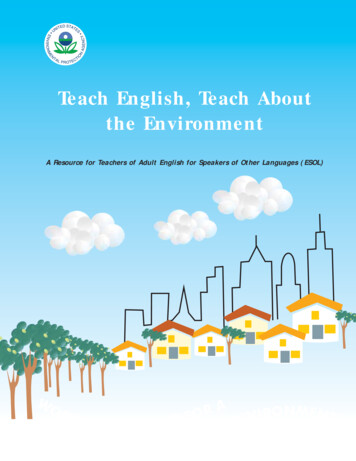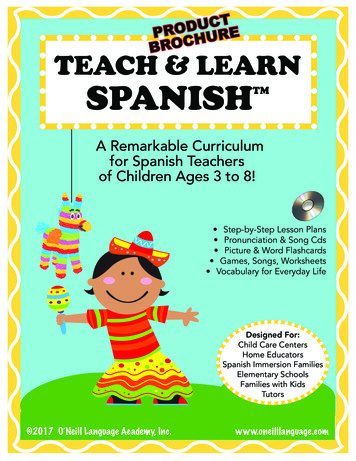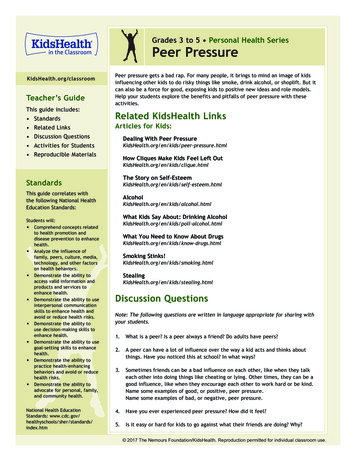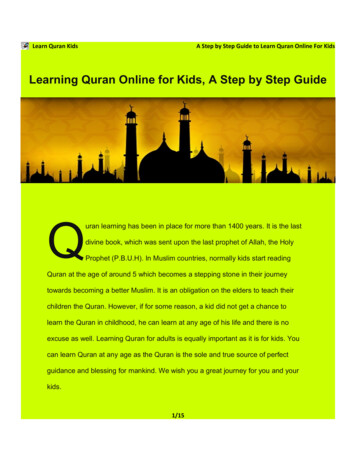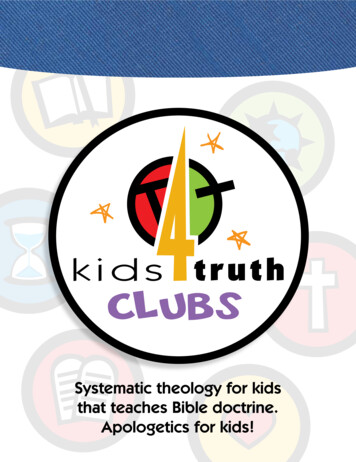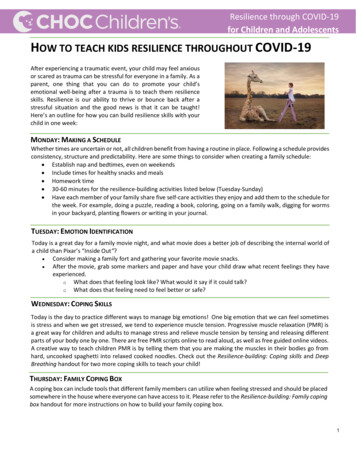
Transcription
Resilience through COVID-19for Children and AdolescentsHOW TO TEACH KIDS RESILIENCE THROUGHOUT COVID-19After experiencing a traumatic event, your child may feel anxiousor scared as trauma can be stressful for everyone in a family. As aparent, one thing that you can do to promote your child’semotional well-being after a trauma is to teach them resilienceskills. Resilience is our ability to thrive or bounce back after astressful situation and the good news is that it can be taught!Here’s an outline for how you can build resilience skills with yourchild in one week:MONDAY: MAKING A SCHEDULEWhether times are uncertain or not, all children benefit from having a routine in place. Following a schedule providesconsistency, structure and predictability. Here are some things to consider when creating a family schedule: Establish nap and bedtimes, even on weekends Include times for healthy snacks and meals Homework time 30-60 minutes for the resilience-building activities listed below (Tuesday-Sunday) Have each member of your family share five self-care activities they enjoy and add them to the schedule forthe week. For example, doing a puzzle, reading a book, coloring, going on a family walk, digging for wormsin your backyard, planting flowers or writing in your journal.TUESDAY: EMOTION IDENTIFICATIONToday is a great day for a family movie night, and what movie does a better job of describing the internal world ofa child than Pixar’s “Inside Out”? Consider making a family fort and gathering your favorite movie snacks. After the movie, grab some markers and paper and have your child draw what recent feelings they haveexperienced.o What does that feeling look like? What would it say if it could talk?o What does that feeling need to feel better or safe?WEDNESDAY: COPING SKILLSToday is the day to practice different ways to manage big emotions! One big emotion that we can feel sometimesis stress and when we get stressed, we tend to experience muscle tension. Progressive muscle relaxation (PMR) isa great way for children and adults to manage stress and relieve muscle tension by tensing and releasing differentparts of your body one by one. There are free PMR scripts online to read aloud, as well as free guided online videos.A creative way to teach children PMR is by telling them that you are making the muscles in their bodies go fromhard, uncooked spaghetti into relaxed cooked noodles. Check out the Resilience-building: Coping skills and DeepBreathing handout for two more coping skills to teach your child!THURSDAY: FAMILY COPING BOXA coping box can include tools that different family members can utilize when feeling stressed and should be placedsomewhere in the house where everyone can have access to it. Please refer to the Resilience-building: Family copingbox handout for more instructions on how to build your family coping box.1
Resilience through COVID-19for Children and AdolescentsFRIDAY: CONFLICT RESOLUTIONIt is natural for disagreements and conflicts to occur in the home, but how you overcome them is what buildsresilience. Here are some communication rules to establish in your home when a disagreement occurs (see theResources section below for “Fair Fighting Rules” handout): First, check in with yourself and identify what you feel upset about. Bring it up to the person you are upset with and make sure to discuss one issue at a time. For example,“I am upset that I have been washing all the dishes every day.” Be careful to not use degrading or derogatory language and to not raise your voice. The goal here is tohave a productive and healing conversation. Use “I” statements when expressing how you feel so you are taking responsibility for your feeling. Forexample, say “I feel hurt when ” instead of saying “You made me mad ” Be mindful of not interrupting each other. You can set a one-minute timer to let everyone have theirtime to speak. Take a timeout when things start getting heated. Identify a length of time you need a break for, so theother person knows you are planning on returning to the conversation. For example, “I am feelingoverwhelmed right now and need a 15-minute break from this conversation.” Remember that you are working toward a compromise or at least a shared understanding of thesituation, so go into this conversation with that mindset.SATURDAY: MINDFULNESSMindfulness is a powerful tool to help us slow down, pay attention and be fully present in the moment. Refer to thePracticing Mindfulness handout for more ways to teach your child mindfulness. Sit on the floor facing your child. You can sit on a cushion or pillow. You can use a bell or a singing bowl(there are free ones online) to call your child into focus and attention. Encourage your child to listen to the bell until it is no longer chiming or singing. It may only last a fewseconds, but those few seconds of their complete attention is very powerful. Make it a game and have them raise their hand when they can’t hear it anymore and see who has thebetter hearing.SUNDAY: GRATITUDETo end the weekend on a good note, let’s engage in practicing gratitude for all the things we have and get toexperience. Research has found that teaching gratitude to children increases their happiness, optimism andgenerosity. One way to teach your child about gratitude is to pair gratitude with a symbol. For example, every timeyou see an airplane in the sky, you remind yourself to think of one thing you are grateful for. This will help reinforcethe practice of gratitude throughout your day. Please refer to the Cultivating Gratitude and Mood Booster Jarhandout for creative ways to teach your child about gratitude.CONSIDERATIONSHere are some things to consider when engaging in all these activities with your child: Make sure to have it be a technology-free time, and you are providing your child with your full attention. Listen and reflect on what your child is saying while engaged in the exercises. When your child says, “Mom,I am using the red marker to draw a red, mad face!” you can respond by saying, “You’re picking the redmarker to draw your mad face.” Provide praises throughout the activity to encourage and reinforce positive behaviorsFeel free to continue to repeat elements of this weeklong schedule as many times as you want. The reinforcementof these skills is what helps make it stick for children, so the more practice, the more we are increasing theirresilience — or their capability of taking on challenging situations.RECOMMENDED RESOURCESFair Fighting Rules ing-rules.pdf2
Deep Breathingfor Children8 GREAT WAYS TO PRACTICE DEEP BREATHINGBREATHING WITH BUBBLESHold out a bubble wand and take a deep breath in. Then, breathe outslowly and gently and watch the bubbles form and float around theroom.PINWHEEL BREATHINGHold out a pinwheel and breathe slowly on the pinwheel to get it to spin. If you blow too harsh or toofast, it might not move. Slow, deep breaths get the pinwheel spinning around and around.SMELL THE FLOWER AND BLOW OUT THE CANDLESPretend you are smelling a beautiful, fragrant flower. Take a deep breath in to fully take in the scent. Nowpretend that in front of you is a birthday cake with lots of candles. Take a deep breath out to blow out allthose candles. Practice breathing in the flower and blowing out the candles a couple of times.SMELL AND COOL THE HOT CHOCOLATEPretend you have a piping hot cup of cocoa in your hands. You are excited to take a sip, but first you needit to cool down. You inhale the smell of the delicious hot chocolate and then blow slowly on it to cool itdown.ROCKET SHIPStand or sit upright and place your hands together in front of your chest like you are a rocket about to getready for takeoff! Take a deep breath in and count down from five. When you get to 0, blast off into spaceby lifting your hands in an upward motion until your arms are straight up above your head. Add awhooshing sound to your rocket as you take off by exhaling aloud!DRAGON BREATHINGTake a deep breath in through your nose and breathe out through your mouth. As you breathe out,attempt to do a small dragon roar. You can even move your arms like dragon wings as you breathe in andout!STUFFED ANIMAL BREATHINGLay down and place a stuffed animal on your belly. Take a few deep breaths in and out and watch yourbelly move the stuffed animal up and down.BACK TO BACK BREATHINGFind a partner and sit on the ground with your backs pressed together. Sit upright and tall and take a deepbreath in and slowly exhale. Your partner should feel you breathing on the other side. Now practicebreathing in and out at the same time and try to synchronize your breaths.Recommended books:Alphabreaths: The ABCs of Mindful Breathing by Christopher Willard, Daniel Rechtschaffen, & Holly Clifton-BrownBee Calm: The buzz on yoga by Frank J. SileoBreathe by Ines Castel-BrancoPeaceful Piggy Meditation by Kerry Lee MacLeanRecommended es/default/files/DeepBreathingforChildren.pdf1
Resilience Building: Coping Skills Worksheetin Children and AdolescentsRESILIENCE BUILDING: COPING SKILLSGrounding is an activity that brings your attention to the presentmoment. One of the best and most readily available ways to dothat is to use your five senses (see, touch, hear, smell, and taste).Have your child fill out the questions below to help manage bigemotions.WHAT ARE FIVE THINGS YOU SEE IN THIS ROOM?WHAT ARE FOUR THINGS YOU FEEL?WHAT ARE THREE THINGS YOU HEAR?WHAT ARE TWO THINGS YOU SMELL?WHAT IS ONE THING YOU TASTE?RESOURCESVisit CHOC.org/CoronaVirus for more Resilience Tools1
Resilience Building: Coping Skills Worksheetin Children and AdolescentsRESILIENCE BUILDING: FAMILY COPING BOXA coping box includes tools that different family members can utilize when feeling stressed. It can includeitems that feel soft, taste good, or smell soothing. Encourage your child to use the box when they arestarting to feel agitated, stressed, sad, mad or restless.WHAT YOU’LL NEEDShoe BoxConstruction Paper, Stickers, or otherDecorative ItemsGlueCoping ItemsINSTRUCTIONS1. GRAB THE SHOE BOX AND DECORATE THE OUTSIDE WITH THE WHOLE FAMILY2. HAVE EVERY MEMBER OF THE FAMILY COLLECT A COPING ITEM OR TWO.These things could be: Soft stuffed animalWord searchesPleasant-smelling candle or lotionChewing gumList of songs that bring joyFidget toysPrintable of breathing exercises3. PLACE THE BOX WHERE EVERYONE CAN ACCESS IT EASILY.RESOURCESVisit CHOC.org/CoronaVirus for more Resilience Tools2
Practicing Mindfulnesswith ChildrenPRACTICING MINDFULNESS WITH CHILDRENMindfulness is a powerful tool to help us slow down, pay attention and be fully present in the moment.Below is a list of fun and creative ways to teach your child mindfulness:MAKE YOUR WALKS MINDFULTake a “noticing” walk with your child and try to notice things youhaven’t paid attention to before. Use your 5 senses and identifywhat you see, hear, feel, and smell around you. Designate the firstminute of your walk as “silent walking” and pay attention to all thatis around you and then come together to discuss the things younoticed.MINDFUL MANTRASMantras are helpful when we need to calm ourselves down andbring ourselves back into the present moment. Create a list ofphrases that you and your child can repeat silently as you take adeep breath. Here are some examples:I am thankful.Let it go.I will be okay.This too shall pass.With change comes opportunity.MINDFUL COLORINGPrint out some coloring pages and practice coloring mindfully. Teach them to practice deep breathing asthey color.PRACTICE MINDFUL EATINGEat a snack mindfully. Or, maybe just the first bite of a snack! For example, if the snack is an apple slice,have your child examine the apple as if they are an alien from outer space seeing an apple slice for thefirst time. What does it look like? What does it feel like? What does it smell like? Does light shine throughit? Take a small bite but don’t swallow just yet. What is this bite like? Chew slowly. Take it all in. Talk aboutthat bite afterward. What are new things they have discovered about the apple?BRING MINDFUL AWARENESS OF ROUTINE ACTIVITIESWe can practice bringing our mindful attention to daily activities that are often performed mindlessly. Pickone of these activities to serve as your “Call to mindfulness” during the day: brushing teeth, taking ashower, drinking tea/coffee, eating a meal, getting out of bed, getting dressed, waiting in line, turning onyour computer, opening a book to read, washing dishes, folding laundry, getting into bed.PRACTICE MINDFUL MEDITATIONThe loving-kindness meditation is a powerful meditation of sending positive thoughts and wishes toyourself and others. Close your eyes, imagine the person or pet you care about and say aloud or silently,“May you be safe. May you be healthy and strong. May you be happy. May you be peaceful and atease.” These wishes can also be sent to yourself. Have your child pick four wishes they would like to sendand practice saying these with them.Recommended books:A world of pausabilities: An exercise in mindfulness by Frank J. SileoBee Calm: The buzz on yoga by Frank J. SileoBee Calm: An invitation to meditation by Frank J. SileoBreathe by Ines Castel-BrancoPeaceful Piggy Meditation by Kerry Lee MacLeanRelaxations: Big tools for little warriors by Mamen DuchResources:Calm appHeadspace app1
Cultivating Gratitudein Children and AdolescentsCULTIVATING GRATITUDEESTABLISH A GRATITUDE PRACTICEMake a list of all the things you are grateful for today. Forexample, “I am grateful that we didn’t hit traffic on our drive toschool” or “I am grateful for the good weather we are having.”Try to practice gratitude for all the little things that occur duringthe day that people tend to overlook, but can make a difference.CREATE A GRATITUDE CUEPair gratitude with a symbol. For example, every time you see an airplane, you have to think of one thingyou are grateful for. This will help reinforce the practice of gratitude throughout your day.WRITE A THANK YOU CARDOnce a week write a thank you card for someone you are feeling grateful for, whether it is a teacher,pediatrician, librarian, or a family member.GRATITUDE TRADITIONCreate a gratitude tradition in your home and get others involved. Whether it is going around the dinnertable and having each family member say 1 thing they are grateful for or writing down 3 things you aregrateful for in your journal before bed.ALPHABET GRATITUDEWrite down each letter of the alphabet and come up with one thing you are grateful for based on eachletter. For example, B can be for books if you have a lot of books that you enjoy reading, or S can be forsunsets because it is your favorite time of the day.GRATITUDE JARPlace an empty jar on your desk with strips of blank paper next to it. Every time you remember or reflecton something you are grateful for, write it down and put it in the jar. Every once in awhile, read all yourappreciative thoughts.Recommended books:Grow Grateful by Sage Foster-Lasser and Jon LasserGrow Kind by Jon Lasser and Sage Foster-LasserGrow Happy by Jon Lasser and Sage Foster-LasserBee Heartful: Spreading Loving-Kindness by Frank J. SileoRecommended -exercises/1
Mood Booster Jarfor Children and AdolescentsMOOD BOOSTER JARA mood booster jar holds strips of paper with encouragingstatements that friends or family members have written about you.Place this jar somewhere visible and whenever you’re having atough day, pull out a strip of paper to get some love andencouragement.WHAT YOU’LL NEED1 Empty Jar, small box, or containerMarkers or pensTape or glueConstruction paper cut into stripsDecorative items like stickers or ribbonsScissors to cut the construction paper into stripsINSTRUCTIONS1. GATHER THE FAMILY OR A GROUP OF CLOSE FRIENDS AND PROVIDE THEM EACH WITH A JAR2. EACH PERSON LABELS THEIR JAR WITH THEIR NAME AND DECORATES IT AS THEY WISH3. EVERYONE CUT THE SHEETS OF CONSTRUCTION PAPER INTO STRIPS4. ON SEPARATE STRIPS OF PAPER, EACH PERSON WRITES AT LEAST 5 POSITIVE THINGS ABOUT EACH OTHER AND PLACESIT IN EACH OTHER’S INDIVIDUAL JARS. SOME INSPIRATION CAN INCLUDE:a.b.c.d.e.A famous or inspirational quote that reminds you of this personWhat do you appreciate about them?Why are your grateful for this person?What is a positive or funny memory that you have with this person?What are some of their strengths or things that they are uniquely good at?5. AFTERWARD, EACH PERSON CAN TAKE TURNS SHARING WHAT EVERYONE WROTE ABOUT THEM IN THEIR JAR IF THEY’DLIKE, OR THEY CAN KEEP IT A SURPRISE FOR WHEN THEY ARE NEEDING THAT EXTRA BOOST ON A DIFFICULT DAYRecommended books:Grow Grateful by Sage Foster-Lasser and Jon LasserGrow Kind by Jon Lasser and Sage Foster-LasserGrow Happy by Jon Lasser and Sage Foster-LasserBee Heartful: Spreading Loving-Kindness by Frank J. SileoRecommended -exercises/1
DRAGON BREATHING STUFFED ANIMAL BREATHING Lay down and place a stuffed animal on your belly. Take a few deep breaths in and out and watch your belly move the stuffed animal up and down. B ACK TO BACK BREATHING Find a partner and sit on the ground with your backs pressed together. Sit upright and tall and take a deep breath in and slowly exhale.

